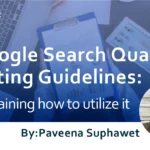What Are Outbound Links? Explaining Outbound Links That Affect SEO Evaluation
contents

Outbound links, also known as external links or backlinks, are links placed on a webpage that direct users to other pages. Proper placement of outbound links within a webpage significantly influences SEO evaluation.
However, it’s not merely about placing outbound links arbitrarily. Understanding the role outbound links play in web content is crucial for effective placement.
Hence, to gain high ratings in SEO, let’s delve into the essence of outbound links and effective strategies for their placement.
Related Articles on Outbound Links:
What Are External Links? Understanding External SEO Tactics
What Are Inbound Links? Explaining Citations
What are Outbound Links?
Outbound links refer to links generated within a webpage that direct users to other pages within the same website or to external websites.
For instance, a global menu summarizing the content available on a site often contains multiple outbound links to navigate users to various pages within the site.
In SEO evaluation, it’s crucial to ensure that the outbound links direct users to the appropriate webpages within the site.
Two Types of Outbound Links
Outbound links are categorized into two types based on whether they lead to pages within the same website or external websites.
Internal Links: Outbound links that direct users to other pages within the same website. External Links: Outbound links that direct users to pages on other websites.
Internal Links
Internal links are outbound links within the same website that direct users to relevant pages.
The purpose of internal links is to comprehensively provide valuable information that meets user needs. By including internal links to obtain necessary related or supplementary information, users can the information they need simply by reading through the content.
Therefore, when placing internal links, it’s crucial to interlink relevant information or supplementary content within the same website like a web of connections.
However, it’s risky to indiscriminately place internal links just because they’re deemed important for SEO evaluation.
Internal links serve as tools to deepen user understanding of the content and meet user needs adequately. Simply placing them does not automatically result in SEO evaluation. When placing internal links, it’s important to consider the following two points
- Is the linked page related to the information on the current page?
- Does the linked webpage enhance user understanding?
External Links
External links, also known as outbound links, are links placed on a website that direct users to external websites.
By linking to reputable external websites through external links, it’s possible to enhance the usefulness and credibility of your own content.
External links include outbound links as well as inbound links. Inbound links refer to links from external sites to your own site.
Being linked to by external sources serves as evidence that your content is valuable and trustworthy from a third-party perspective, making it an important factor for gaining high ratings in SEO.
SEO Effects of Outbound Links
Webpages with appropriately placed outbound links are highly evaluated by Google because they assist in meeting user needs.
This is supported by Google’s explicit mention of the basic policy for SEO within its quality guidelines, stating
‘Create pages with the user in mind, not search engines.’
Source: Webmaster Guidelines (Google AdSense Help)
When your company’s content appears at the top of search results, the probability of increasing website traffic significantly rises. Increasing website traffic is essential for boosting conversion rates.
Conditions for Maximizing the SEO Effects of Outbound Links
There are three main conditions for maximizing the SEO effects of outbound links
- Quantity of Outbound Links
- Quality of Outbound Links
- Attributes of Links
Quantity of Outbound Links
The number of outbound links should be within a reasonable range based on the amount of valuable information for users.
There are no strict limitations on the specific number of outbound or inbound links. Google’s quality guidelines mention the following:
‘Keep the number of links on a page reasonable (up to a few thousand).’
Source: Webmaster Guidelines (Google Search Central)
Outbound links should be placed to adequately convey necessary information to users without making it cumbersome for them to access the linked content.
How to Check the Number of Outbound Links
To understand the number of outbound links, utilize SEO tools. Here are two tools for checking outbound links, both of which are free to use
- SEO Check!
- SEONET.JP
You can check the number of outbound links by entering the URL of the respective website into these tools.
Quality of Outbound Links.
The quality of outbound links is crucial for SEO evaluation. There are primarily three conditions that determine the quality of outbound links
- Links leading to relevant pages
- Links to trustworthy websites
- Mutual linking with reputable sites
Inappropriately placed outbound links do not contribute to SEO evaluation.
Outbound links are meant to supplement information on the current page for users. However, users are inevitably stressed when forced to navigate to linked pages. Therefore, outbound links should only be placed when necessary and provide essential information without imposing inconvenience on users.
If the information on the linked webpage does not meet user needs, it can be said that users are being needlessly misled.
In SEO, prioritizing user convenience is crucial. Merely aiming to increase website traffic and session duration by deploying outbound links within the site, without adequately meeting user needs, does not garner positive evaluation from Google.
Internal links naturally increase on valuable websites.
Internal links should not be increased artificially but should grow organically as the website’s content expands to meet user needs. Websites that comprehensively cover information from various perspectives can naturally incorporate multiple internal links. This is what Google aims for in enhancing user convenience.
Increasing the number of internal links through superficial methods alone is insufficient. It’s essential to nurture the entire website.
Appropriate external links enhance content value
If necessary to meet user needs, external links should be deployed. Particularly, linking to content from authoritative sources such as government agencies or specialized experts in specific fields is effective. This is because
- Providing more reliable information to users
- Elevating webpage evaluation by basing content on information from credible sites
With the development of the internet, everyone can easily disseminate information, but at the same time, there is a possibility of spreading unreliable information. This is such a serious issue that even the Ministry of Internal Affairs and Communications has raised concerns.
The widespread use of the internet and social networking services (SNS) has made it easier to send and receive information. While this has many benefits, such as easy access to various information, it has also led to the proliferation of false information, fake news, and misinformation on the internet.
Source: Ministry of Internal Affairs and Communications White Paper, 2021 edition, Part 1, Special Feature: Life and Economy Supported by Digital Technologies (Ministry of Internal Affairs and Communications)
“ First, we fundamentally design our ranking systems to identify information that people are likely to find useful and reliable.
To complement those efforts, we also have developed a number of Search features that not only help you make sense of all the information you’re seeing online, but that also provide direct access to information from authorities—like health organizations or government entities.
Finally, we have policies for what can appear in Search features to make sure that we’re showing high quality and helpful content. “
Quoted from: How Google delivers reliable information in Search ( The Keyword )
In order to provide users with reliable information, Google adopts specific measures and policies to prioritize websites that meet user needs in search results. They also mention developing features that make it easy for users to access information from government agencies and authoritative institutions.
By placing backlinks to reputable websites, users can obtain more accurate and credible information without the need for additional searches. This enhances usability, ensuring a high-quality user experience.
Becoming an authority in every field is practically impossible. However, by linking to information shared by experts in various fields, your content can be backed by reputable websites, enhancing its credibility and trustworthiness.
Properly placing external links helps improve usability while leveraging authority, which in turn contributes to SEO evaluation.
The Risks of Outbound Links
There are two risks associated with outbound links
- There’s a risk that users may leave your own content.
- If outbound links are not appropriate, they won’t contribute to SEO evaluation.
Two Measures to Prevent User Departure
User departure mainly occurs when users access external links. To prevent users from leaving your site when referring to external links, it’s recommended to implement the following measures
- Display external websites in separate windows
- Cite external sites as references or sources
Setting up our site to remain open while opening the linked site ensures that users can easily return to our site after finishing browsing the external site, effectively preventing user departure.
Additionally, representing external sites as references or sources can also prevent users from leaving the current webpage.
Careful Selection of External Link Destinations
Both internal and external links must be appropriate. Especially when selecting sites to link to externally, if the quality of the destination site is extremely poor or lacks credibility, it may diminish the credibility of your own site.
When choosing external sites, prioritize reputable public information or websites of social authorities in specific fields to enhance the credibility of our content.
Beware of Broken Links
Being vigilant about broken links is essential for enhancing usability and improving SEO evaluation.
A broken link occurs when a user accesses a link but can’t reach the webpage, resulting in messages such as ‘Page not found’ or ‘404 Not Found’.
Even if users put effort into accessing the linked page, if it doesn’t exist, their needs won’t be met, rendering their efforts futile. This doesn’t align with user-friendliness.
Moreover, leaving broken unaddressed links may lead Google to perceive the site as outdated. Presenting outdated information lowers credibility and significantly decreases SEO evaluation.
The Causes of Broken Links
There are two main causes of broken links
- Input errors when setting up the link
- The linked site being outdated
When setting up outbound links, it’s crucial to pay close attention to avoid input errors in the URL of the destination site and ensure that it’s accessible.
Additionally, after setting up the link, there’s a possibility that the linked site may be deleted or closed for some reason. This can occur not only with external sites but also within our own site due to reasons like site migration.
To address this, it’s essential to regularly check for broken links.
Broken links can be checked using various tools, including WordPress plugins and tools provided by Google Search Console. These tools range from free to paid versions, so utilize the one that suits you best to prevent broken effectively links.
Below are some popular broken link checking tools
- Link Checker (dead-link-checker.com)
- Broken Link Checker
- Index Coverage Report (Google Search Console)
Summary
The purpose of setting up outbound links is to meet user needs and enhance usability. No matter how well-crafted a webpage is, it’s impossible to perfectly meet all user needs without any flaws. Properly placed outbound links complement the information users seek while providing them with reliable information, stilling confidence.
It’s essential to anticipate and provide necessary information within your own content so users don’t have to search around. This is the role of outbound links. In SEO, sites that prioritize user convenience like this are positively. evaluated, placing outbound links appropriately is not easy. To gain SEO evaluation, it’s necessary to increase both outbound and inbound links. Continuously updating content with the latest information is crucial to earn trust from society and Google alike.










![What is a Description? Explaining the Meaning, Writing Style, and Changing Word Count – [2023 Edition]](https://www.switchitmaker2.com/en/wp-content/uploads/2024/09/what-is-description.webp)










